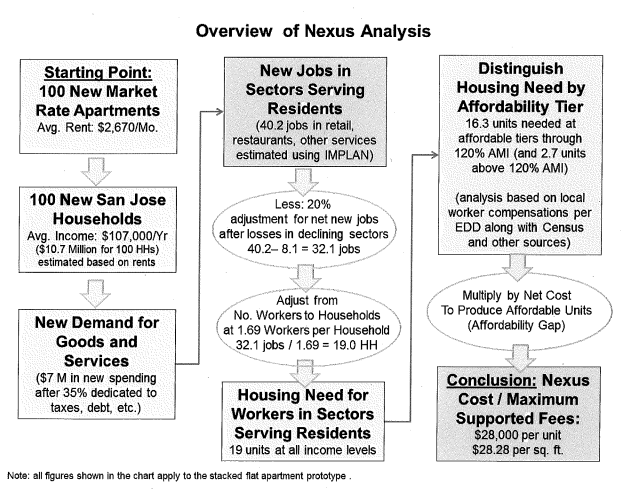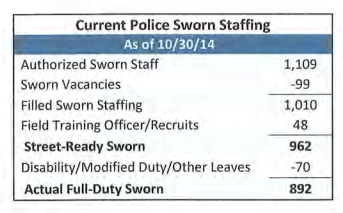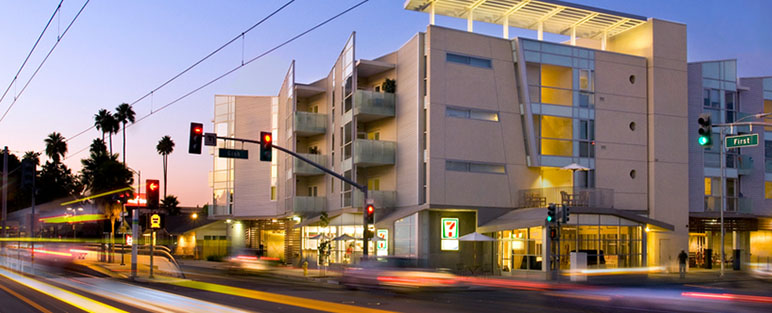Taking the lead from nearby Bay Area cities, San Jose is poised to enact a developer fee to help pay for affordable housing.
The proposal up for consideration at Tuesday's City Council meeting calls for a housing impact fee of $17 for every square foot of new market-rate housing, with a 2.4 percent annual increase to keep up with inflation.
Several other Bay Area cities have a similar fee, including Mountain View, San Carlos, San Francisco, Berkeley, Daly City, Emeryville and Santa Rosa. Advocates say it's vital to subsidize housing, given the dramatic shortage of affordable units in Silicon Valley. But developers say the added cost will discourage new construction.
Average rents in San Jose have jumped 49 percent since 2010, according to RealFacts. They've increase nearly 11 percent in the past year alone to an average of $2,230 a month. City officials estimate the actual deficit is 16,315 affordable units.
San Jose imposed a similar fee years ago, called the inclusionary housing fee, but that was challenged in court by developer groups.
Before proposing a new fee, the city had to come up with a "nexus study," to verify the link between new market-rate construction and the dearth of affordable housing. The study supported fees at high as $28 a square foot.

San Jose came up with a similar fee years ago—which required developers to include affordable housing units or pay an in-lieu $17-a-square-foot fee—but that was challenged in court by the Building Industry Association.
Suspension of inclusionary housing fees was coupled with the loss of affordable housing funding from local redevelopment agencies, which the state ordered dissolved in 2012. Combined, that's resulted in a $200 million annual shortfall in affordable housing funds.
Councilman Don Rocha says the city should also look at extending a fee to non-residential development—to lower the rate and broaden the base.
"[I]t seems out of sorts for us to place a fee on housing after constraining its development," he writes in a memo. "It seems that it would be much more logical and fair to place a significantly lower fee on both commercial and residential development."
Another possibility, he adds: look at building micro-apartments to offer even more affordable options for low-income workers.
Council members Sam Liccardo and Madison Nguyen are asking for an exemption for high-rise residential development in downtown.
Mayor Chuck Reed issued a memo later in the day Monday that says the nexus study failed to prove that building more housing causes the need for more affordable housing.
"Without proof of causation, the housing impact fee 'walks like a tax' and 'it talks like a tax,'" Reed wrote. "Why not at least make the effort to prove that there is an impact and avoid the tax fight?"
More from the San Jose City Council agenda for November 18, 2014:
- Earlier this fall, Rocha asked for a review of the police department. That report comes up for discussion this week—you can read it here. It shows that the agency employs 892 full-duty sworn officers. The resignation rate is three to four officers a month.

- Deploying bomb-sniffing dogs at the Mineta San Jose International Airport will cost the city more than $200,000 a year.
- A man who claims he was wrongfully arrested by San Jose police is about to get a $190,000 settlement from the city. Ammir Umar was arrested and jailed for a month on suspicion of selling boxes of wood he told customers contained flat-screen TVs. He faced several years in prison on charges of grand theft. But prosecutors let him go after a judge determined that Sgt. Craig Storlie made "patently incorrect" and "materially misleading" statements that led to Umar's arrest. Storlie is one of the officers in charge of San Jose Police Department's Internal Affairs unit, which looks into ethics complaints against other cops.
- San Jose will enact an ordinance that requires contractors hired by the city to pay their workers at least prevailing wage. The ordinance comes after Gov. Jerry Brown, in 2013, signed SB 7, which prevents low-ball contractors from skirting California's prevailing wage rules. Prevailing wage refers to the average hourly wage and benefits paid to employees in the region. It's generally less than a "living wage," which is what it would take for a worker to support their household.
- Another ordinance will enact a second-tier pension plan for all new San Jose Fire Department employees, a result of the city's voter-approved pension reforms.
- Mayor Chuck Reed, who's terming out at the end of the year, will hold a farewell celebration the evening of Dec. 17.
- Four council members are calling for the city to extend a tax break for developers building in North San Jose. "We are hopeful that a crane in the sky will bode well for more speculative building construction in North San Jose in the near future," reads the memo co-signed by Don Rocha, Sam Liccardo, Mayor Reed and Rose Herrera.
- Reed, Herrera and Rocha signed a related memo that proposes relaxing design guidelines to encourage corporate tenants to move to North San Jose.
- The city will extend the lease agreement for the San Jose Improv comedy club for another year, then probably put the property up for sale.
WHAT: City Council meets
WHEN: 1:30pm Tuesday
WHERE: City Hall, 200 E. Santa Clara St., San Jose
INFO: City Clerk, 408.535.1260


Re relaxing tax breaks and design standards. I am surprised by Rocha signing this, not by the others. In case you did know know this, other cities do not offer the kind of incentives that SJ does to attract these projects. Because we do this sets up a bad precedent. Why should you care? Because monies not put into traffic mitigation fees etc means more traffic and more bad roads and no money to fix them.
> Advocates say it’s vital to subsidize housing, given the dramatic shortage of affordable units in Silicon Valley.
Translation: all the housing in Silicon Valley is occupied AND IS THEREFORE AFFORDABLE BY SOMEONE!
> Several other Bay Area cities have a similar fee, including Mountain View, San Carlos, San Francisco, Berkeley, Daly City, Emeryville and Santa Rosa.
Those people who deem that they can’t afford housing in San Jose should go to Mountain View, San Carlos, San Francisco, Berkeley, Daly City, Emeryville or Santa Rosa for housing.
Problem solved.
San Jose has a huge housing/jobs imbalance. Housing in general represents a net monetary loss for cities. Jobs are a net gain for cities, taxwise. “Affordable” housing increases that imbalance, due to the tax structure. So now, SJ, which has budget problems due to the housing/jobs imbalance, wants to make the housing/jobs imbalance worse by authorizing more “affordable” units.
The tables in the report on police staffing make it seem that we have had very few resignations/retirements in the last four years. Yet we all know there has been a significant reduction in the number of officers on the street. How can that be? The city has manipulated the numbers by reducing the number of authorized positions. What a load of crap.
This is the second time I have seen the photo at the top identify Gish Apartments as being located in downtown San Jose. They are in fact a couple of miles north of downtown San Jose.
JMO,
That intersection is a cess pool.. I wonder if the photog had to shoe the homeless and vagrants away for a half hour just to take that photo.
The table you probably saw in the staffing report is for Communications staffing. When I first saw it without reading the title, I almost spit my coffee all over my phone! I figured Chuck had dug his abacus out once again and cooked the numbers Rufus style, extra crispy. Fortunately, it just outlines how poorly staffed SJPD Communications is with dispatchers working 12-16 hours shifts in addition to mandatory overtime!
JMO,
You are exactly correct about the manipulation of staffing numbers. It used to be around 1,450 and got dropped to around 1,100 now. Also, the reported cited above being submitted by the Chief to the City Council is more playing with numbers. It says the department loses 4-5 officers per month, when the losses for the past 4 years have been around 120 officers per year, or at least 10 per month.
I’m for it along as it doesn’t include downtown. The downtown area should be exempt.
Guess U live downtown, Mr. NIMBY
Don’t fret your little head. Downtown has been declared a low income housing free zone for a couple of decades or more. When was the last new low income or senior housing project built there. With Liccardo continuing the sad precedent by the now defunct RDA of downtown for a one dimensional monied enclave, any funds generated will put these invisible folks outside where they belong. No matter that downtown is the transit hub of Santa Clara County. Who are the primary users of VTA? Hmm, would that be the ones who don’t own cars? Students, low income, and seniors? Never mind. I was just trying to be logical not political. Lets face it. Barry and his friends direct Council on what is no less than social engineering for maximized developer profits. I forgot, with major subsidies that make low income subsidies pale by comparison.
Daily my commute from Almaden Expressway and 85 is about 1 hour 15 minutes to Palo Alto. Too many cars on the road, or too many people, too little jobs in San Jose?
Don’s actions don’t surprise me. Go look at his 460’s.
The correct term for a developer fee is a buyer’s penalty, as the price of a new 2,000 square foot home will be $34K over the market rate. Of course, the higher price of the new home will certainly up the price of comparable “newer” homes (landscapes already matured, neighborhood established, etc.), thus extending the buyer’s penalty to buyers of them (with the profits going to the sellers). This penalty will continue to impact other properties right down to the level where it keeps a few dozen would-be first time home buyers stuck in the rental market (but they’re probably motivated by the desire to move away from Norteños and Sureños, so who really cares about people of such low tolerance?).
If the city is serious about managing the housing market I suggest it do something to drive home prices down, not up. This it can do by offering longtime home owners an incentive to put their houses on the market so as to create the inventory necessary. The proper incentive would be cash, enough so that sellers could afford to buy in one of the surrounding municipalities that is better run than this city (this means any surrounding municipality). I believe the chance to move to a city that views providing services to its residents as more important than demonstrating servility to its ethnic minorities will prove so exciting as to create the seller’s panic necessary to start San Jose home prices tumbling. Who knows, it may drive values low enough to make first-time home owners out of Prop 47 releasees and Mayor Reed’s sanctuary wetbacks, and justify changing the city’s motto to, “San Jose — the Salinas of Silicon Valley.”
Oh happy, multicultural, day!
Lets go one step further. Tenement housing should be brought to downtown. Luxury high-rises should be offset by low-income projects. I also believe that the new light-rail/BART system should terminate in Willow Glen and Almaden Valley. Fair consideration should also be given to the people living in the “jungle” on the eastside, to bring them into the mainstream as quickly as possible by constructing more low income housing along the Bird/Almaden corridor.
What the hell do I care…i cant afford to live here anymore, so I think we should be as fair as possible to the low income people. Enjoy what you built San Jose Voters…..